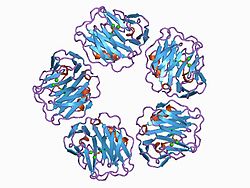Mammalian protein found in humans
C-reactive protein (CRP ) is an annular (ring-shaped) pentameric protein found in blood plasma , whose circulating concentrations rise in response to inflammation . It is an acute-phase protein of hepatic origin that increases following interleukin-6 secretion by macrophages and T cells . Its physiological role is to bind to lysophosphatidylcholine expressed on the surface of dead or dying cells (and some types of bacteria) in order to activate the complement system via C1q .[ 5]
CRP is synthesized by the liver [ 6] macrophages , T cells and fat cells (adipocytes ).[ 7] pentraxin family of proteins.[ 6] C-peptide (insulin) or protein C (blood coagulation). C-reactive protein was the first pattern recognition receptor (PRR) to be identified.[ 8]
^ a b c GRCh38: Ensembl release 89: ENSG00000132693 – Ensembl , May 2017^ a b c GRCm38: Ensembl release 89: ENSMUSG00000037942 – Ensembl , May 2017^ "Human PubMed Reference:" . National Center for Biotechnology Information, U.S. National Library of Medicine .^ "Mouse PubMed Reference:" . National Center for Biotechnology Information, U.S. National Library of Medicine .^ Thompson D, Pepys MB, Wood SP (February 1999). "The physiological structure of human C-reactive protein and its complex with phosphocholine" . Structure . 7 (2): 169–177. doi :10.1016/S0969-2126(99)80023-9 PMID 10368284 . ^ a b Pepys MB, Hirschfield GM (June 2003). "C-reactive protein: a critical update" . The Journal of Clinical Investigation . 111 (12): 1805–1812. doi :10.1172/JCI18921 . PMC 161431 PMID 12813013 . ^ Lau DC, Dhillon B, Yan H, Szmitko PE, Verma S (May 2005). "Adipokines: molecular links between obesity and atheroslcerosis". American Journal of Physiology. Heart and Circulatory Physiology . 288 (5): H2031–H2041. doi :10.1152/ajpheart.01058.2004 . PMID 15653761 . ^ Mantovani A, Garlanda C, Doni A, Bottazzi B (January 2008). "Pentraxins in innate immunity: from C-reactive protein to the long pentraxin PTX3". Journal of Clinical Immunology . 28 (1): 1–13. doi :10.1007/s10875-007-9126-7 . PMID 17828584 . S2CID 20300531 . 





